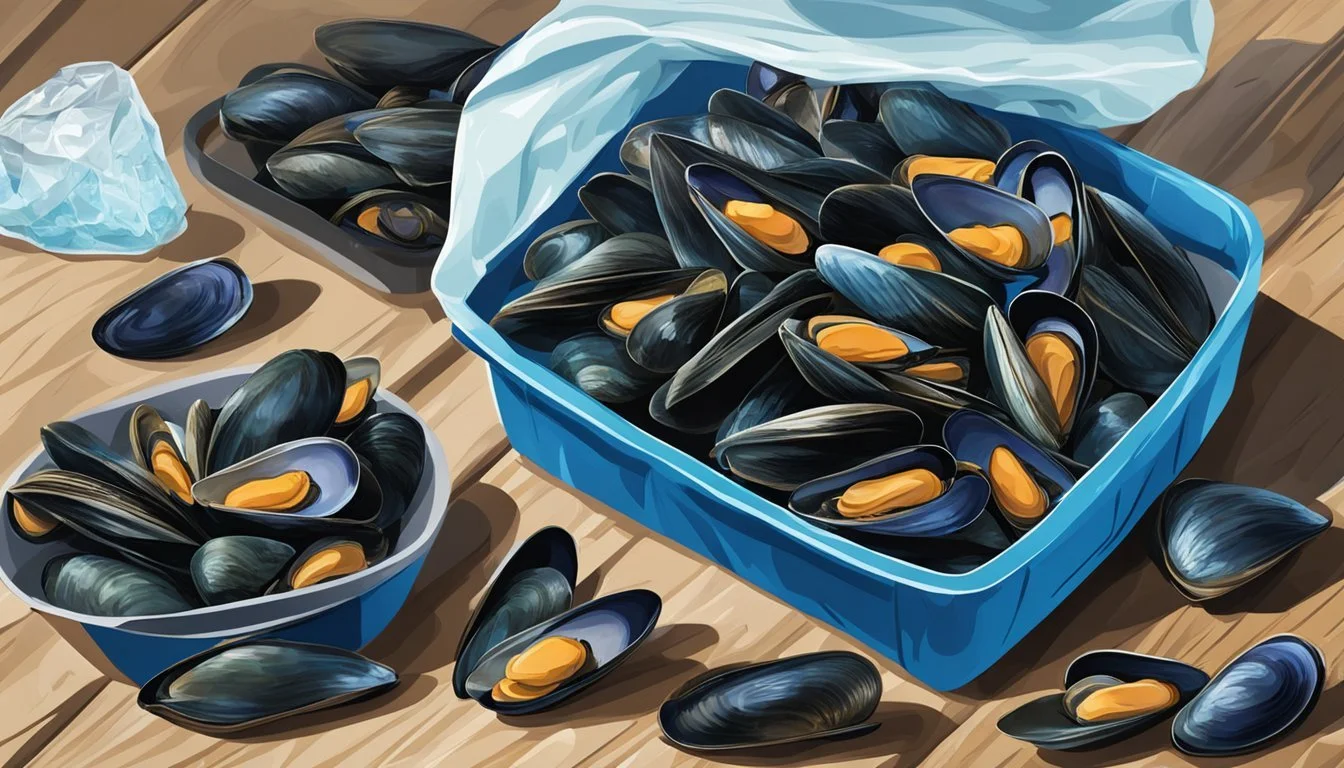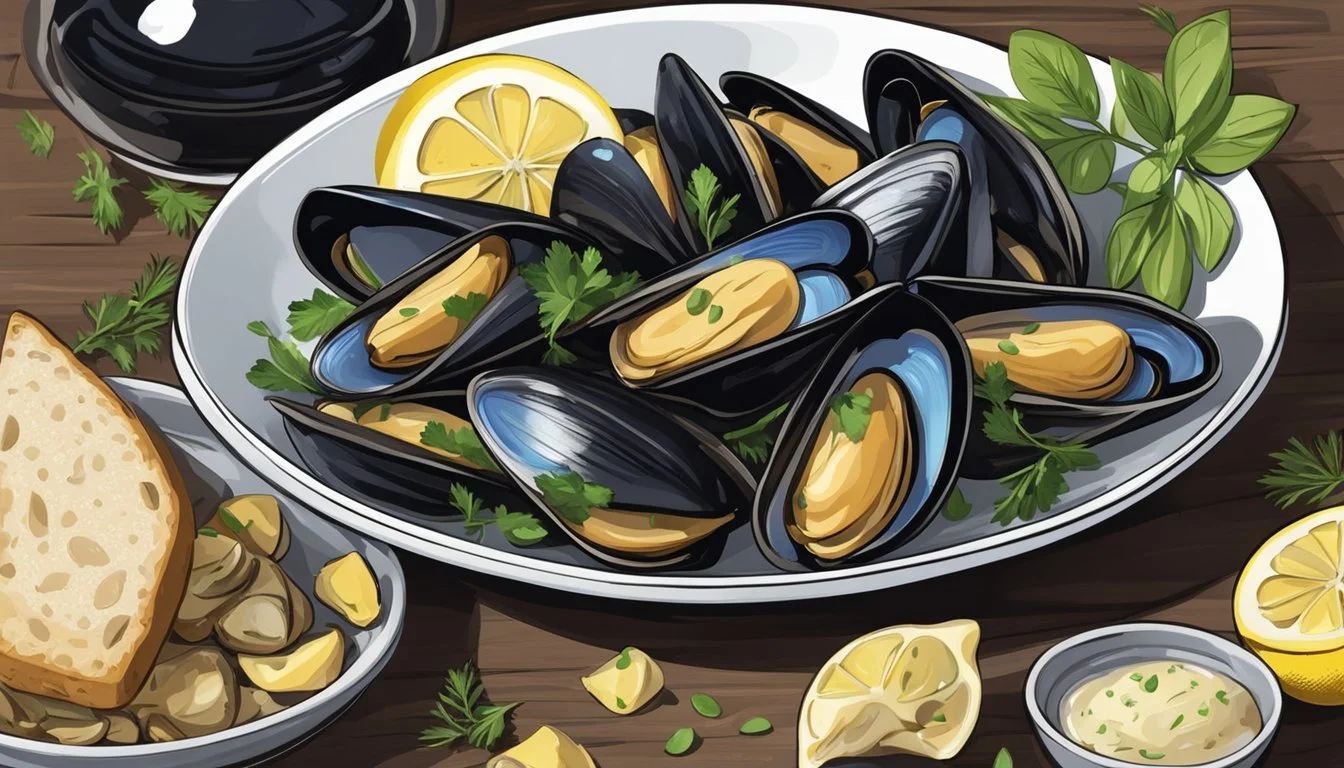Fresh vs Frozen Mussels: A Comparison of Flavor, Texture, and Convenience
Mussels are a popular seafood delicacy enjoyed by many. When it comes to choosing between fresh and frozen mussels, consumers often wonder which option is superior. Fresh mussels are generally considered the best choice for optimal flavor and texture, but frozen mussels can be a convenient and viable alternative when fresh are unavailable.
Fresh mussels have a delicate, briny taste and tender texture that frozen varieties may struggle to match. They are typically sold live with tightly closed shells, ensuring peak freshness. However, fresh mussels require careful handling and should be consumed within a day or two of purchase.
Frozen mussels offer convenience and extended shelf life. They are pre-cooked and frozen quickly to preserve quality. While they may not have the exact same texture as fresh, frozen mussels can still be flavorful and work well in various recipes. They are also more widely available year-round and can be a good option for those without easy access to fresh seafood.
Comparing Fresh and Frozen Mussels
Fresh and frozen mussels each offer distinct advantages and considerations for consumers. Their availability, nutritional content, taste, and texture can vary significantly based on how they are sourced and preserved.
Availability and Seasonality
Fresh mussels are typically available year-round but may be more abundant during certain seasons. Coastal areas often have easier access to fresh mussels. Frozen mussels provide a convenient alternative, available in most supermarkets regardless of location or time of year.
Rope-grown, farm-raised mussels are considered a sustainable choice for fresh options. These mussels grow on ropes attached to poles in bays or oceans, ensuring consistent quality and availability.
Frozen mussels offer flexibility in storage and use. They can be kept for extended periods, allowing consumers to enjoy mussels even when fresh ones are not readily available.
Nutritional Value
Both fresh and frozen mussels retain their nutritional benefits when handled properly. Mussels are rich in protein, omega-3 fatty acids, vitamins, and minerals.
Freezing does not significantly degrade the nutritional content of mussels. Processors use subzero temperatures to preserve the proteins, healthy fats, vitamins, and minerals inherent in seafood.
Fresh mussels may have a slight edge in nutrient retention, as they haven't undergone any processing. However, the difference is minimal when frozen mussels are processed quickly and stored correctly.
Taste and Texture Considerations
Fresh mussels are prized for their delicate, briny flavor and tender texture. When cooked properly, they have a soft, slightly chewy consistency.
Frozen mussels can maintain much of their original flavor, especially if frozen shortly after harvesting. Their texture may be slightly altered due to the freezing process, sometimes resulting in a softer consistency.
Cooking methods can affect the taste and texture of both fresh and frozen mussels. Steaming or sautéing are popular techniques for both types. Fresh mussels are often preferred for dishes where the pure, unadulterated flavor is crucial.
Frozen mussels may be more suitable for recipes with strong flavors or sauces that can complement their slightly altered texture. They are also convenient for use in soups, stews, and pasta dishes.
Preparation of Mussels
Proper preparation is crucial for enjoying delicious mussels. This involves thawing frozen mussels, cleaning them thoroughly, and cooking them correctly.
Thawing Frozen Mussels
Place frozen mussels in a bowl and cover with cold water. Let them thaw in the refrigerator overnight or for several hours. This gradual thawing process helps preserve texture and flavor.
For quicker thawing, place sealed mussels in a colander under cool running water. Gently stir occasionally to ensure even thawing. This method takes about 30 minutes.
Never use hot water or microwave to thaw mussels, as this can partially cook them and affect quality.
Debearding and Cleaning
Rinse thawed mussels under cold water to remove debris. Check each mussel for cracks or open shells that don't close when tapped - discard these.
To debard, grip the fibrous "beard" near the hinge and pull firmly towards the opening edge. Some mussels may not have visible beards.
Scrub shells with a stiff brush to remove sand and barnacles. Rinse again under cold water.
How to Cook Frozen Mussels
Steaming is a popular method for cooking mussels. Place them in a large pot with a small amount of liquid (water, wine, or broth). Cover and cook over medium-high heat for 5-7 minutes until shells open.
For sautéing, heat olive oil in a pan. Add garlic and cook until fragrant. Add mussels and white wine. Cover and cook for 3-4 minutes, stirring occasionally.
Baking is another option. Preheat oven to 425°F (220°C). Arrange mussels on a baking sheet, drizzle with olive oil, and bake for 8-10 minutes.
Discard any mussels that remain closed after cooking. Serve immediately with desired sauce or garnishes.
Cooking Techniques for Mussels
Mussels can be prepared using various methods, each offering unique flavors and textures. The key is to cook them until the shells open, signaling they're done.
Steaming Mussels
Steaming is a classic and efficient way to cook mussels. Place cleaned mussels in a large pot with a small amount of liquid, such as white wine or broth. Add aromatics like garlic, shallots, and herbs for extra flavor.
Cover the pot and steam over medium-high heat for 3-5 minutes. Shake the pot occasionally to ensure even cooking. The mussels are ready when their shells have opened wide.
Discard any mussels that remain closed after cooking. Serve immediately with the flavorful cooking liquid and crusty bread for dipping.
Baking Mussels
Baking mussels creates a delicious crust while maintaining their tenderness. Preheat the oven to 425°F (220°C). Arrange cleaned mussels on a baking sheet in a single layer.
Drizzle with olive oil and sprinkle with herbs, breadcrumbs, or grated cheese. Bake for 8-10 minutes until the shells open and any toppings are golden brown.
For a more elaborate dish, stuff partially cooked mussels with a mixture of breadcrumbs, herbs, and cheese before baking. This creates a flavorful, crispy topping.
Sauteing Mussels
Sauteing mussels produces a quick, flavorful meal. Heat olive oil or butter in a large skillet over medium-high heat. Add aromatics like garlic and shallots, cooking until fragrant.
Add cleaned mussels to the hot pan. Cook for 3-4 minutes, stirring or shaking the pan occasionally. The mussels are done when their shells open.
Remove the mussels as they open, keeping them warm. Continue cooking any unopened shells for another minute or two. Serve with the pan juices and fresh herbs.
Grilling Mussels
Grilling imparts a smoky flavor to mussels. Preheat the grill to medium-high heat. Clean and debeard the mussels, then place them directly on the grill grates.
Cook for 3-5 minutes until the shells open. Use tongs to remove opened mussels, discarding any that remain closed.
For easier handling, place mussels in a grill basket or on a sheet of foil with holes poked in it. Brush with olive oil and sprinkle with herbs before grilling.
Flavor Enhancements
Elevating the taste of mussels involves incorporating complementary ingredients and seasonings. The right additions can transform these mollusks into a truly memorable dish.
Aromatic Additions
Garlic is a classic pairing with mussels, infusing them with a pungent, savory flavor. Mince 2-3 cloves and sauté in butter or olive oil before adding the mussels. Lemon brightens the dish with its citrusy zest. Squeeze fresh lemon juice over cooked mussels or add lemon wedges for diners to use at their discretion.
Herbs like cilantro and basil contribute freshness and complexity. Chop a handful of cilantro and sprinkle it over the mussels just before serving. For a Mediterranean twist, tear fresh basil leaves and scatter them on top of the dish.
Seasoning and Spices
Black pepper adds a subtle heat that complements the brininess of mussels. Freshly ground pepper is preferable for its more robust flavor. Use it sparingly to avoid overpowering the delicate taste of the mussels.
Breadcrumbs can add texture and absorb flavors. Toast them in a pan with butter and garlic, then sprinkle over the mussels before serving. For a cheesy finish, grate Parmesan over the dish. Its nutty, salty flavor enhances the overall taste profile.
Sauce Pairings
Garlic sauce is a popular choice for mussels. Create a simple version by sautéing minced garlic in butter, then adding white wine and simmering until reduced. Pour this sauce over the mussels just before serving.
For a richer option, try a creamy white wine sauce. Combine equal parts white wine and heavy cream, simmer until slightly thickened, then add a pat of butter for richness. This sauce pairs well with the natural juices released by the mussels during cooking.
A tomato-based sauce offers a tangy contrast to the mussels' sweetness. Sauté garlic and onions, add canned crushed tomatoes, and simmer with herbs like basil and oregano for a Mediterranean-inspired dish.
Serving Suggestions
Mussels pair wonderfully with a variety of accompaniments and dishes. The right sides enhance the briny flavors and complement the tender texture of these shellfish.
Accompaniments
Fresh crusty bread is essential for soaking up flavorful mussel broth. Sourdough baguettes or garlic bread work perfectly. French fries offer a crispy contrast to tender mussels. Steamed vegetables like broccoli or green beans provide a light, nutritious option.
For a refreshing touch, serve a simple tomato salad with red onions and herbs. Caesar salad with Parmesan croutons adds a tangy element. Lemon wedges are crucial for squeezing over mussels just before eating.
Consider seafood paella for a more substantial meal. The rice absorbs the mussel juices, creating a rich flavor profile.
Pasta and Bread Pairing
Angel hair pasta tossed in garlic butter sauce complements mussels beautifully. The delicate noodles don't overpower the shellfish. For a creamier option, serve mussels over fettuccine Alfredo.
Linguine alle vongole, traditionally made with clams, works well with mussels too. The light olive oil and white wine sauce enhances the seafood's natural flavors.
Garlic confit toast is an elevated bread option. Spread soft, roasted garlic cloves on toasted baguette slices. This adds depth to the mussel-eating experience.
For a unique twist, serve mussels over creamy polenta. The smooth texture contrasts nicely with the shellfish.
Health and Nutrition
Mussels pack a powerful nutritional punch, offering an array of essential nutrients. Their impressive profile makes them a valuable addition to a healthy diet, supporting various bodily functions and overall well-being.
Protein and Fat Content
Mussels are an excellent source of high-quality protein. A 3-ounce serving provides approximately 20 grams of protein, making them an ideal choice for muscle maintenance and growth. This amount represents about 40% of the recommended daily protein intake for most adults.
Mussels are relatively low in fat and calories. The same 3-ounce portion contains only about 146 calories, with minimal fat content. This makes them a lean protein option suitable for weight management and heart health.
The fat in mussels is primarily composed of beneficial omega-3 fatty acids. These healthy fats support brain function, reduce inflammation, and promote cardiovascular health. A single serving of mussels can provide around 500 milligrams of omega-3s.
Minerals and Vitamins
Mussels are rich in essential minerals. They are particularly high in iron, crucial for oxygen transport in the body and maintaining energy levels. Zinc is another abundant mineral in mussels, supporting immune function and wound healing.
Vitamin B12 is a standout nutrient in mussels. This vitamin is vital for nerve function, DNA production, and the formation of red blood cells. A single serving of mussels can provide a significant portion of the daily recommended intake of B12.
Other B vitamins found in mussels include B6 and riboflavin. These contribute to energy metabolism and cognitive function. Mussels also contain smaller amounts of vitamins A and E, which support eye health and act as antioxidants.
Food Safety and Storage
Proper handling and storage are critical for maintaining the quality and safety of both fresh and frozen mussels. Following food safety guidelines helps prevent foodborne illness and ensures the best eating experience.
Recognizing Freshness and Spoilage
Fresh mussels should have tightly closed shells or close when tapped. The shells should be free of cracks and have a mild, salty scent. Discard any mussels with broken shells or that remain open after tapping.
Frozen mussels should be solidly frozen with no signs of freezer burn. When thawed, they should appear plump and moist with a translucent appearance.
Avoid mussels with an unpleasant, fishy odor as this indicates spoilage. Discoloration or slimy texture are also signs the mussels are no longer safe to eat.
Leftover Storage
Store leftover cooked mussels in an airtight container in the refrigerator for up to 3-4 days. Refrigerate within 2 hours of cooking to prevent bacterial growth.
For longer storage, freeze cooked mussels in moisture-proof packaging for up to 3 months. Thaw frozen leftovers in the refrigerator overnight before reheating.
Never leave cooked mussels at room temperature for more than 2 hours. If serving cold, keep dishes on ice to maintain safe temperatures below 40°F.
Cooking and Serving Tips
Cooking mussels, whether fresh or frozen, requires attention to detail for the best results. For frozen mussels, thawing is crucial. Place them in the refrigerator overnight or submerge the sealed package in cold water for quicker defrosting.
Steam is an excellent method for cooking mussels. In a large pot, bring a flavorful liquid like white wine, garlic, and herbs to a simmer. Add the mussels and cover, cooking for 3-4 minutes until they open.
Frozen mussels offer convenience, often pre-cooked and requiring only reheating. For a quick option, place them in a microwave-safe dish with a splash of water, cover, and heat in short bursts until warm.
On the stovetop, sauté thawed mussels in a pan with olive oil, garlic, and parsley for a simple yet delicious preparation. Cook until heated through, about 2-3 minutes.
Discard any mussels that remain closed after cooking. Serve immediately with crusty bread to soak up the flavorful broth. Lemon wedges on the side add a bright, fresh touch to the dish.
For a more substantial meal, toss cooked mussels with pasta or use them as a topping for risotto. Their briny flavor complements a variety of cuisines and ingredients.




